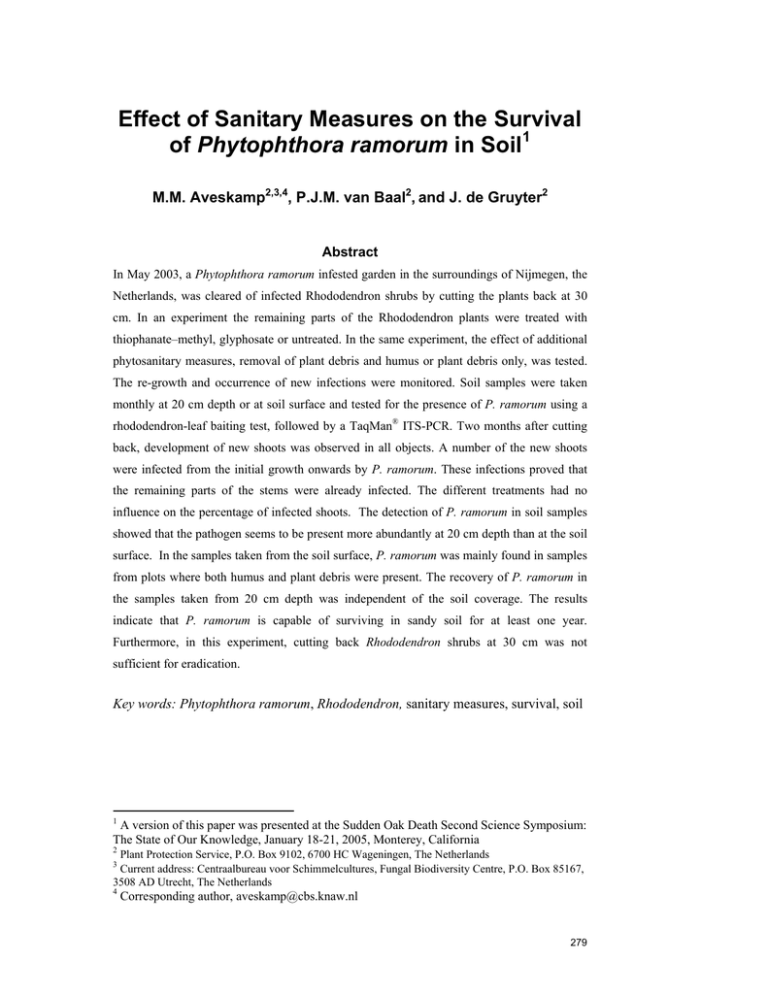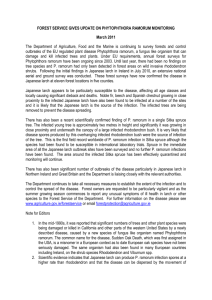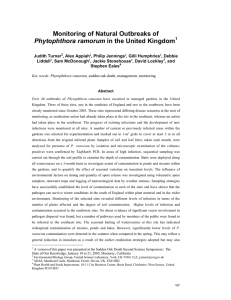Effect of Sanitary Measures on the Survival Phytophthora ramorum M.M. Aveskamp
advertisement

Effect of Sanitary Measures on the Survival of Phytophthora ramorum in Soil1 M.M. Aveskamp2,3,4, P.J.M. van Baal2, and J. de Gruyter2 Abstract In May 2003, a Phytophthora ramorum infested garden in the surroundings of Nijmegen, the Netherlands, was cleared of infected Rhododendron shrubs by cutting the plants back at 30 cm. In an experiment the remaining parts of the Rhododendron plants were treated with thiophanate–methyl, glyphosate or untreated. In the same experiment, the effect of additional phytosanitary measures, removal of plant debris and humus or plant debris only, was tested. The re-growth and occurrence of new infections were monitored. Soil samples were taken monthly at 20 cm depth or at soil surface and tested for the presence of P. ramorum using a rhododendron-leaf baiting test, followed by a TaqMan® ITS-PCR. Two months after cutting back, development of new shoots was observed in all objects. A number of the new shoots were infected from the initial growth onwards by P. ramorum. These infections proved that the remaining parts of the stems were already infected. The different treatments had no influence on the percentage of infected shoots. The detection of P. ramorum in soil samples showed that the pathogen seems to be present more abundantly at 20 cm depth than at the soil surface. In the samples taken from the soil surface, P. ramorum was mainly found in samples from plots where both humus and plant debris were present. The recovery of P. ramorum in the samples taken from 20 cm depth was independent of the soil coverage. The results indicate that P. ramorum is capable of surviving in sandy soil for at least one year. Furthermore, in this experiment, cutting back Rhododendron shrubs at 30 cm was not sufficient for eradication. Key words: Phytophthora ramorum, Rhododendron, sanitary measures, survival, soil 1 A version of this paper was presented at the Sudden Oak Death Second Science Symposium: The State of Our Knowledge, January 18-21, 2005, Monterey, California 2 Plant Protection Service, P.O. Box 9102, 6700 HC Wageningen, The Netherlands Current address: Centraalbureau voor Schimmelcultures, Fungal Biodiversity Centre, P.O. Box 85167, 3508 AD Utrecht, The Netherlands 3 4 Corresponding author, aveskamp@cbs.knaw.nl 279 GENERAL TECHNICAL REPORT PSW-GTR-196 Introduction Rhododendron proved to be the main source of infection for Phytophthora ramorum in the public green in the Netherlands. Results of surveys indicate that a complete eradication of P. ramorum is not possible. Most important is to obtain an acceptable reduction of the infection pressure especially to avoid spread of P. ramorum from infected Rhododendrons to trees nearby. Questions arose about the methods of eradication, and the means of handling the infected plant material. In addition, data about the infection level and the longevity of P. ramorum in soil at infested sites was lacking. A field experiment was conducted to test the effect of cutting back infected rhododendron plants at 30 cm compared to removing whole rhododendron plants. The effect of treatment of the stumps with an herbicide or fungicide on the occurrence of re-infections was also studied. In addition, burying infected plant material at 1 m depth, or burning all infected plant material at the site is not always possible and may involve high costs. Therefore, in the same experiment phytosanitary measures, such as removal of plant debris and humus or plant debris only, was compared with leaving the chipped plant debris and humus on the soil surface. Soil samples were taken monthly at 20 cm depth and at the soil surface and tested for the presence of P. ramorum, to determine the infection levels in soil during the experiment. Material and methods In May 2003, a P. ramorum infected garden in the surroundings of Nijmegen, the Netherlands, was cleared of infected Rhododendron shrubs by cutting back the plants at 30 cm. In another experiment, on nine 200 m2 plots, the remaining stumps of the approximately 70-year old Rhododendron plants were treated with thiophanate– methyl, glyphosate or left untreated. The different plant debris treatments within each object are given in table 1. The re-growth and occurrence of new infections were monitored monthly in the period from May 2003 to January 2004. 280 Proceedings of the sudden oak death second science symposium: the state of our knowledge Table 1—Treatments. Object A: Application of herbicide on cut rhododendron stumps B: Application of fungicide on cut rhododendron stumps C. Cutting of rhododendrons only Treatments within each object: A1,B1,C1: chipped plant debris and humus left on the soil surface A2,B2,C2: plant debris removed A3,B3,C3: plant debris and humus layer removed The date of the cutting, removal of plant debris and the various fungicide and herbicide applications was May 20, 2003. The fungicide application was carried out with Topsin M/S (thiophanate–methyl). The application of the herbicide Round-up (glyphosate) to each stump was repeated at July 23, 2003. On each plot, a mixed soil sample of 60 sub samples, 1.5 cm diam. was taken monthly at alternating soil surface level or at 20 cm depth, in the period from May 2003 to December 2004. Presence of P. ramorum was tested by a baiting method using freshly picked leaves of Rhododendron catawbiense ‘Cunningham’s White’ (Themann. and Werres 1998), followed by a Taqman® ITS-PCR on the bait (Ivors and Garbelotto 2002). Results Two months after cutting back the shrubs, development of new shoots was observed in all objects (table 2). The lowest numbers were in the glyphosate treatment. However, the re-growth indicates that the treatment was not completely effective. A number of the new shoots were infected from the initial growth onwards by P. ramorum. These infections proved that the remaining parts of the stems were already infected. The different treatments had no reliable influence on the percentage of infected plants. 281 GENERAL TECHNICAL REPORT PSW-GTR-196 Table 2— Percent re-growth and percent infected Rhododendron plants 8 months after cutting at 30 cm and treatment with glyphosate, thiophanate-methyl or untreated. Object # plants percent re-growth percent infected (SD) Glyphosate 64 16 60 (32) Thiophanate-methyl; 75 85 48 (15) Untreated 81 67 41 (13) Table 3— Percent re-growth and percent infected rhododendron plants 8 months after cutting at 30 cm, followed by removal of plant debris and humus, plant debris only or leaving the plant debris on the soil surface. Object # plants percent re-growth percent infected (SD) All debris left 68 57 46 (33) All debris removed 78 68 45 (5) Debris and humus 7 49 47 (20) removed The different treatments in the objects, all debris left, all debris removed and debris and humus removed, did not give reliable differences in the percentage of infected plants (table 3). Probably, infection did not take place from infected soil or plant debris. The detection of P. ramorum in soil samples (fig. 1.) showed that the pathogen seems to be present more abundantly at 20 cm depth than at the soil surface. 282 Proceedings of the sudden oak death second science symposium: the state of our knowledge Figure 1—Number of positive samples period May 2003 to December 2004, at soil surface or at 20 cm depth. # positive samples, May 2003 - December 2004 # positive samples 7 6 5 4 20 cm depth soil surface 3 2 1 0 A1 A2 A3 B1 B2 B3 C1 C2 C3 Object no. Figure 2—Number of positive samples period May 2003 to December 2004 # p o sit ive sam p les (Cu m u lat ive) # positive samples per soil treatment during 1,5 year (cumulative) 20 15 Tot al positives 10 All debris left 5 All debris removed Debis and humus removed 22 -0 5 -2 2 2 0 03 -0 5 21 -03 -0 7 11 -03 -0 9 15 -03 -1 0 13 -03 -1 12 2 03 -1 2 16 -03 -0 1 23 -04 -0 2 17 -04 -0 3 13 -04 -0 4 10 -04 -0 50 8 04 -0 6 12 -04 -0 7 11 -04 -0 8 30 -04 -0 8 28 -04 -0 9 09 -04 -1 12 9 04 -1 104 0 Date This is probably due to a higher variation of environmental conditions in the upper soil surface. In the samples taken from the soil surface, P. ramorum was mainly found in samples from plots where both humus and plant debris were present. The recovery of P. ramorum in the samples taken from 20 cm depth was independent of the soil coverage. 283 GENERAL TECHNICAL REPORT PSW-GTR-196 Conclusions The results indicate that in this experiment cutting back Rhododendron shrubs at 30 cm was not sufficient to eradicate P. ramorum, because new developing shoots became infected directly from the remaining stumps. The percentage re-infected plants, almost 50 percent, was high, however, the number of infected shoots per plant was relatively low. Infected shoots easily break off. Experiences in practice on 40 sites where infected Rhododendrons were cut off, showed that at 50 percent of the sites developing shoots were directly infected from the stumps, usually in low percentages. In this experiment, P. ramorum proved to be capable of surviving in sandy soil for at least one year. The highest number of infections was found in the samples taken at 20 cm depth, in the plots where all debris was left. However, the number of positive samples was relatively low, and the difference was not statistically reliable. References Ivors, K. and Garbelotto, M. 2002. TaqMan® PCR for detection of Phytophthora DNA in environmental plant samples. Abstract Sudden Oak Death, a Science Symposium ‘The state of our knowledge’, Monterey, 56. Themann, K. and Werres, S. (1998). Verwendung von Rhododendronblättern zum Nachweis von Phytophthora-Arten in Wurzel- und Bodenproben. Nachrichtenblatt des Deutschen Pflanzenschutzdienstes 50(2), 37-45. 284





